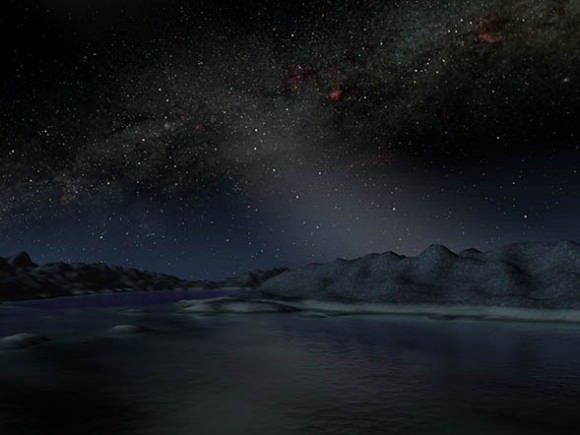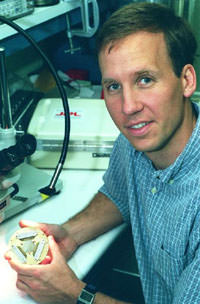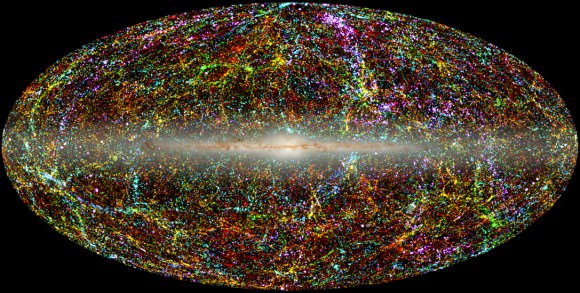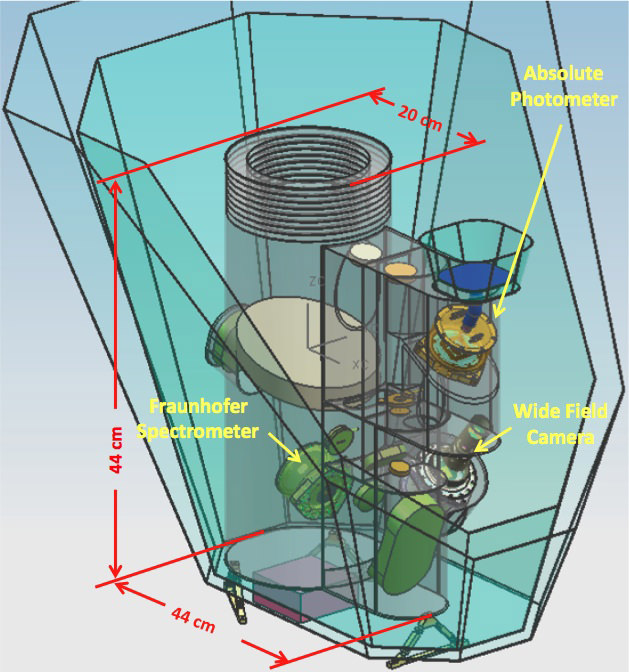[/caption]
Editors note — Science journalist and author Bruce Dorminey spoke to two NASA scientists about the possibility of mounting a telescope on a spacecraft for an outer planets mission.
Light pollution in our inner solar system, from both the nearby glow of the Sun and the hazy zodiacal glow from dust ground up in the asteroid belt, has long stymied cosmologists looking for a clearer take on the early Universe.
But a team at NASA, JPL and Caltech has been looking into the possibility of hitching an optical telescope to a survey spacecraft on a mission to the outer solar system.
Escaping our Inner Solar System’s Polluted Purple Haze
The idea is to use the optical telescope in cruise phase to get a better handle on extragalactic background light; that is, the combined optical background light from all sources in the Universe. They envision the telescope’s usefulness to kick in around 5 Astronomical Units (AU), about the distance of Jupiter’s orbit. The team then wants to correlate their data with ground-based observations.
One goal is to shed light on the early universe’s epoch of reionization. Reionization refers to the time when ultraviolet (UV) radiation from the universe’s first stars ionized the intergalactic medium (IGM) by stripping electrons from the IGM’s gaseous atoms or molecules. This period of reionization is thought to have taken place no later than 450 million years after the Big Bang.
ZEBRA, the Zodiacal dust, Extragalactic Background and Reionization Apparatus, is a NASA JPL concept that calls for a $40 million dollar telescope comprised of three optical/near-infrared instruments; consisting of a 3 cm wide-field mapper and a 15 cm high-resolution imager. However, NASA has yet to select the ZEBRA proposal for one of its missions.
But to learn more, we spoke with the ZEBRA Concept lead and instrument cosmologist Jamie Bock and astronomer Charles Beichman, both of NASA JPL and Caltech.

Dorminey: What is zodiacal light?
Beichman: It’s a bright source of diffuse light in our own solar system from dust grains that emit because they have been heated by the sun and are radiating by themselves
or reflect sunlight. If you go out on a very clear dark moonless light, you can see the band of this light from this dust. It follows the plane of the ecliptic. That dust mostly originates from material in the asteroid belt that gets ground up into little particles after some big collision.

Dorminey: What would getting past this zodiacal dust mean for observations?
Beichman: Imagine sitting in the Los Angeles basin and you’ve got all this smog and haze and you want to measure how clear the air is out at Palm Springs. You have to be able to subtract off all the haze between here and there and there’s just no way to do it with any accuracy. You have to drive out of the basin to get out of the smog.
Dorminey: How would this help in studying this extragalactic background?
Bock: The Extragalactic Background Light (EBL) measures the total energy density of light coming from outside our galaxy. This light gives the sum of the energy produced by stars and galaxies, and any other sources, over the history of cosmic time. The total background can be used to check if we correctly understand the formation history of galaxies. We expect a component of the background light from the first stars to have a distinct spectrum that peaks in the near-infrared; this can tell us how bright and how long the epoch was when the first stars were forming. Unfortunately, zodiacal light is much brighter than this background. But by going to the orbit of Jupiter, the zodiacal light is 30 times fainter than at Earth, and at the orbit of Saturn it is 100 times fainter.
Dorminey: Would you have to hitchhike on a NASA mission or could it be a partnership with another space agency, like ESA for instance?
Bock: We have been exploring the cheapest incremental cost approach, partnering with a NASA planetary mission. But we could partner with another space agency. The European Jupiter Icy Moons Explorer (formerly JGO) is now competing for the next L-class mission launch in the early 2020’s and is an attractive possibility for a contributed cruise-phase science instrument. Each approach comes with a different cost and partnership environment.
Dorminey: Is the prime driver for the EBL telescope to get beyond the zodiacal dust or does 5 AU also offer an observational advantage in terms of achieving faintness of magnitude?

Bock: There is an observing advantage due to the [darker solar system] background. With such a small telescope, we are not trying to exploit this benefit but future observatories could. We will measure the zodiacal brightness to Jupiter and beyond, and this may motivate astronomical observations with telescopes in the outer solar system in the future.
Dorminey: What sort of data downlink challenges would you encounter?
Bock: The data requirements are perhaps smaller than one might first expect, because our images are obtained with long [observational] integrations at moderate spatial resolution. For the planetary proposal we studied in detail, the total data volume was 230 gigabytes, with about 65 percent of this data being returned from Jupiter and out to Saturn. The telescope pointings operate autonomously.
Dorminey: What about radiation from Jupiter interfering with the optics and CCD cameras on the telescope?
Beichman: What you’d do is stop making the EBL observations while close to Jupiter. The radiation problems are significant, so you would only do observations before and after passing Jupiter.

Dorminey: What would your instruments do that NASA’s planned James Webb Space Telescope (JWST) wouldn’t?
Bock: JWST will likely detect the brightest first galaxies, and depending exactly how galaxies formed, will miss most of the total radiation due to the contribution of many faint galaxies. Measuring the extragalactic background gives the total radiation from all the galaxies and provides the total energy. Furthermore, we don’t need a large telescope; 15 cm is sufficient.
Dorminey: What about planetary science with the telescope?
Bock: Our instrument specializes in making low surface-brightness measurements. We made specific design choices to map the zodiacal dust cloud from the inner to the outer solar system. A 3-Dimensional view will let us trace the origins of interstellar dust to comets and asteroid collisions. We know there are Kuiper-belt objects beyond the orbit of Neptune, and it is likely there is dust associated with them as well.
Dorminey: How long would this telescope function?
Bock: After the prime observations complete, it would certainly be possible that the original team or an outside party could propose to operate the telescope. One exciting science case is parallax micro-lensing observations; observations that use the parallax between Earth and Saturn to study the influence of exo-planets orbiting the stars producing a micro-lensing event. Other science opportunities include maps of the Kuiper Belt in the near-infrared; stellar occultations by Kuiper Belt Objects; and mapping more EBL fields for comparison with other surveys.
Dorminey: How would the telescope’s initial observations potentially shake up theoretical cosmology?
Beichman: Whenever you do a measurement that’s a factor of a hundred times better than before, you always get a surprise.


It would be a totally different mission, but imagine the accuracy of astrometry measurements using a telescope piggybacked on an outer solar system probe. The baseline would expand many times over the 1 AU that Hipparchos and the forthcoming Gaia will operate.
AND the observations would be done in the same time, so there will be no problems with changing surface of big stars like Betelgeuse
The problem there is the ‘piggybacked’; the space astrometry missions are using ludicrously careful engineering – GAIA’s whole optical bench is, I believe, a chemically-bonded single block of silicon carbide – and metrology to keep everything as un-wobbly as possible, whilst an outer-system probe will not generally have the space and the fine-guidance control to work with that accuracy.
Earth-to-Voyager-1 is already a 120AU baseline, so Epsilon Eridani would appear 40 arc-seconds shifted against the distant stars, which is twenty Voyager-1-camera pixels … if the camera on Voyager 1 still worked that might be a nice public-outreach demonstration, but I think it’s dead.
Hope they get the lens right the first time.
Is there substantial value in having two probes in the outer solar system, on opposite sides of the sun, and making simultaneous observations of the same nearby stars?
It seems like having a longer baseline would let you trigonometrically establish the distance to nearby stars more accurately, and figure out the distance to more distant stars. Doing the observations simultaneously instead of waiting 6 months for the Earth to move would help to eliminate the effects of proper motion. I’m just not sure if that’s worth hundreds of millions of dollars. Astronomers, is that data something that would be valuable to you?
Measuring the distance to stars with greater accuracy wouldn’t be of much use, I’d expect, given the expense. But a telescope setup like you describe could provide unrivalled resolution if it were possible to link the telescopes up for the purpose of interferometry. Wikipedia says:
“Very Long Baseline Interferometry uses a technique related to the closure phase to combine telescopes separated by thousands of kilometers to form a radio interferometer with the resolution which would be given by a single dish which was thousands of kilometers in diameter.”
Imagine having access to the resolution of a solar-system-sized telescope!